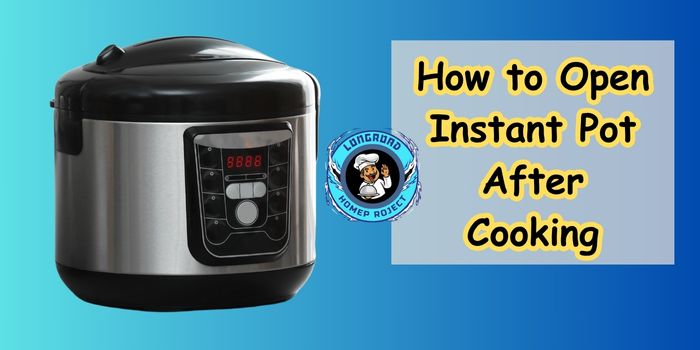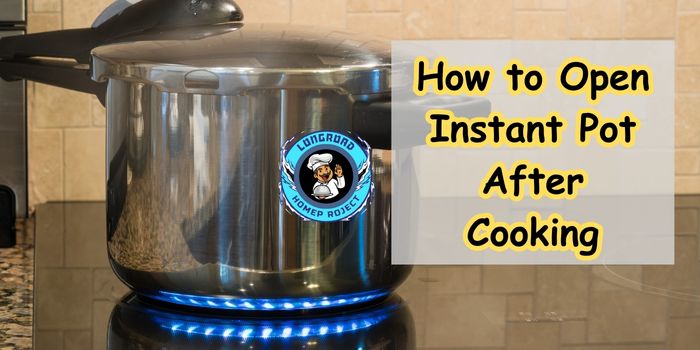As an Amazon Associate I earn from qualifying purchases.
If your Instant Pot won’t open—or you’re afraid of opening it wrong—you’re not alone. I made that mistake once too. And let me tell you, it’s a little scary staring at a sealed pot of piping hot food, wondering if it’s safe to twist that lid. Knowing how to open an Instant Pot after cooking isn’t just about convenience—it’s about safety, confidence, and protecting your delicious meal.
In this guide, we’ll walk through everything you need to know about opening your Instant Pot safely and correctly. We’ll cover:
- The different pressure release methods (manual vs. natural)
- What to expect after the cooking cycle ends
- Common reasons your lid might be stuck
- Step-by-step instructions for opening your Instant Pot after making rice, chicken, or any other meal
- And crucial safety tips that could prevent burns or accidents
Whether you’re new to pressure cooking or just ran into a sticky situation (literally or figuratively), this article will help you feel 100% confident about your next Instant Pot meal—from pressurizing to plating. Let’s get started.
Instant Pot Pressure Mechanics
How the Instant Pot Builds and Releases Pressure (and Why It Matters Before You Open It)
To truly understand how to open an Instant Pot after cooking, it helps to know what’s going on under the hood—literally. The Instant Pot works by creating a sealed environment where steam builds up to cook food faster and more evenly than traditional methods. This pressure-cooking magic relies on a very specific set of mechanics inside the pot that you should be familiar with before attempting to open the lid.
How Pressure Builds Inside the Instant Pot
Once you select a cooking program and hit “Start,” the Instant Pot begins heating the contents. As the liquid inside heats up, it turns to steam. Because the pot is sealed, this steam can’t escape—so it begins to pressurize the cooking chamber.
Here’s a simplified breakdown of how pressure builds:
- The lid locks automatically once pressure starts to build.
- The sealing ring expands slightly to form an airtight seal.
- Steam pressure increases until it hits the preset level (typically 10.2–11.6 psi for most models).
- Once it reaches this point, the Instant Pot maintains pressure by regulating internal temperature and reducing heat intermittently.
This high-pressure environment drastically reduces cooking time while tenderizing meats and locking in flavors.
Why You Must Release Pressure Before Opening
Once the cooking cycle finishes, the Instant Pot doesn’t magically depressurize—it holds that steam until you actively release it. If you try to open the lid before releasing pressure, the pot physically won’t let you. It’s built with a locking pin safety mechanism that prevents the lid from twisting off when it’s under pressure.
But that’s not just for convenience—it’s for your safety.
Opening the Instant Pot while it’s still pressurized could cause:
- Dangerous steam burns
- Food or liquid explosions
- Damage to the sealing ring or lid components
That’s why fully releasing the pressure is absolutely essential before trying to remove the lid. You have two main ways to do that: natural release and manual (quick) release, which we’ll explore next.
Steam Vent Positions: Open or Closed?
Every Instant Pot has a steam release valve, often referred to as the steam vent. This is the knob or switch that controls whether steam stays inside the pot or vents out.
Here’s how to tell which position it’s in:
- Closed (Sealing) – This is the position during cooking. It traps steam to allow pressure to build.
- Open (Venting) – This releases steam, either manually or automatically, depending on your model.
Some models, like the Instant Pot Duo or Instant Pot Steam Release Duo, come with a switch-style release button. When cooking is done, you can press the button for quick release, or just wait it out for natural release.
It’s critical to always check the venting position before cooking and never attempt to force the lid open if steam is still escaping or the float valve is still raised.
Key Takeaways for Safe Opening
- Always let the pressure fully release before unlocking the lid.
- Know your Instant Pot model’s venting controls—Instant Pot Steam Release Duo works differently from older models.
- Wait for the float valve (that little silver or red pin) to drop completely before opening.
- Never assume the lid is safe to open just because the timer stopped.
Now that you understand the mechanics, let’s dive into the two main methods of pressure release—and when to use each.

How to Open Instant Pot After Cooking
Safely Opening Your Instant Pot After Cooking
If you’ve just finished cooking and you’re not sure how to open your Instant Pot after cooking—don’t worry. You’re about to learn a safe, foolproof method that works for every recipe, from fluffy rice to tender chicken. Whether you’re new to pressure cooking or ran into a stuck lid, follow these detailed steps to safely unlock your Instant Pot without stress or steam burns.
Wait for the Cooking Cycle to Finish
Once your Instant Pot beeps and the digital display changes (usually to “L00:00” or “Keep Warm”), the cooking phase is complete. But that doesn’t mean it’s safe to open the lid just yet. The pressure is still high inside the pot, and trying to open it now could be dangerous.
➡️ Tip: Keep an eye on the screen—it will start counting up during natural release, giving you a timer reference.
Choose Your Pressure Release Method
Before opening the lid, you must release the built-up pressure using one of two methods:
Natural Pressure Release (NPR)
- The pressure slowly releases on its own over 10 to 30 minutes.
- The float valve will drop down naturally once pressure is fully gone.
- Best for rice, chicken, beans, broths, and meats to prevent splatter and allow juices to settle.
- No action needed—just wait it out.
Manual (Quick) Pressure Release (QPR)
- You manually turn the steam release valve to “Venting” or press the steam release button (on Duo models).
- Pressure is released rapidly with a loud hissing steam noise.
- Ideal for delicate foods like vegetables, eggs, or seafood to avoid overcooking.
- Keep your hand, face, and anything flammable away from the steam vent!
Wait for the Float Valve to Drop
This is the most important sign your pot is depressurized.
The float valve (the little pin near the steam valve) will stay raised when the Instant Pot is under pressure. Once it drops down fully, that’s your signal it’s finally safe to open the lid.
➡️ NEVER try to open the lid if the float valve is still up—you’re asking for a face full of steam or worse.
Gently Open the Lid Counterclockwise
Once the float valve has dropped:
- Twist the lid counterclockwise.
- Lift the lid away from your face, tilting it so any remaining steam vents toward the back or side.
- Be cautious of condensation collecting under the lid—it can drip and cause burns.
➡️ Safety Tip: Always open the Instant Pot in a well-ventilated area and keep children and pets away while releasing steam.
Opening After Specific Recipes
How to Open Instant Pot After Cooking Rice
Use natural release for 10–15 minutes, then release remaining steam if needed. This keeps the rice fluffy and avoids spattering starch.
How to Open Instant Pot After Cooking Chicken
For boneless chicken breasts, a natural release of 10 minutes followed by a quick release works well. For whole chicken or bone-in cuts, let it naturally release fully (15–20 minutes) for juicier results.

Why Your Instant Pot Won’t Open (Top Reasons & Fixes)
If your Instant Pot refuses to open after cooking, don’t force it. There’s usually a logical reason—and a simple fix.
Here are the top reasons why your Instant Pot lid may stay stuck, along with how to fix them:
| Problem | Why It Happens | How to Fix It |
|---|---|---|
| 🔺 Float valve is still up | Pressure hasn’t fully released | Wait longer or do a quick release |
| 🔺 Pressure still inside despite release | Food debris blocks the steam release | Jiggle the valve gently or clean it |
| 🔺 Lid lock pin stuck | High pressure or food suction | Let it rest; try pressing the lid down gently |
| 🔺 Steam vent closed | Pressure can’t escape | Turn to venting or use release switch |
| 🔺 Thick foods like stew or chili | Steam is slow to release | Use natural release + gentle valve movement |
Quick Troubleshooting Checklist
- ✅ Check the float valve—if it’s still up, wait.
- ✅ Try tapping or wiggling the steam release knob.
- ✅ Gently press down on the lid—sometimes suction keeps it closed.
- ✅ If food is thick (like oatmeal or stew), give it extra time to release pressure naturally.
- ✅ Turn off and unplug the unit, then wait 10 more minutes before retrying.
Now that you know how to safely open your Instant Pot after cooking, let’s move on to understanding common Instant Pot lid errors, signs of damage, and how to care for your pot long-term to avoid stuck-lid problems in the future.
Here’s the final section, including everything you outlined—how to tell when it’s safe to open the Instant Pot, model-specific lid tips, a personal story, an SEO-rich FAQ block, and a strong, human-style conclusion.
How to Tell When It’s Safe to Open the Instant Pot
When cooking ends, it’s tempting to rush and open the lid—especially if the aroma is irresistible. But the Instant Pot isn’t like a slow cooker or frying pan. Opening it too early can be dangerous. So how do you know when it’s truly safe to open your Instant Pot after cooking?
Here’s how to be 100% sure:
Listen for the Audible Click or Watch the Float Valve Drop
The float valve is a small pin (usually silver or red) located next to the steam release. When the pot is under pressure, the valve is raised. It only drops after all pressure has been released—either naturally or via manual release.
🔔 When the valve drops down completely, you may also hear a faint “click.” That’s your green light—it means the pot is now safe to open.
Wait for Steam to Stop Completely
If you’re doing a quick release, watch the top of the Instant Pot. It will emit a steady stream of hissing steam for a few minutes.
➡️ Once the steam stops and the float valve drops, the pot is depressurized.
Never try to open the lid while there’s still visible steam or hissing.
Check the Display for “L” Time or “Keep Warm” Mode
After cooking, the Instant Pot often switches to “Keep Warm” mode and begins a countdown timer starting with L00:00. That “L” stands for “lapsed time” since cooking finished.
This timer is a useful indicator of how long it’s been depressurizing naturally:
- 10 minutes = minimum for soft items like rice
- 15–20 minutes = ideal for meats and stews
If it’s still showing the cook time or steam is venting, it’s too soon.
Model-Specific Lid Opening Tips
Not all Instant Pots open the same way. Depending on your model, the pressure release and lid removal may work differently.
Instant Pot Duo & Duo Plus
- Use the steam release valve (manual knob on top).
- Turn it from Sealing to Venting for a quick release.
- Wait for float valve to drop before turning the lid counterclockwise.
Instant Pot Pro & Max
- Use the steam release button or automated release feature.
- Some models will release pressure in stages and beep when it’s safe.
- Lid often clicks gently when it’s ready to be opened.
Use Accessories When Needed
- If the steam release is hard to reach, use a wooden spoon to turn the valve.
- Consider buying a silicone steam diverter to redirect the vent away from cabinets.
The First Time I Forced the Lid
I’ll never forget the first time I used my Instant Pot. I’d cooked chicken and was starving. The display beeped, and I thought, “Great, it’s done!” Without reading the manual (big mistake), I tried to open the lid right away.
It wouldn’t budge. I pushed harder. Suddenly—WHOOSH—a cloud of scalding steam shot out from the side. Luckily, I wasn’t directly over the lid, but it scared me enough to step back for good.
Takeaway:
- I hadn’t let the pressure release.
- I didn’t know what the float valve meant.
- I now always check for dropped float valve, no steam, and Lapsed Time display.
Moral of the story? Be patient. It can save you from burns, ruined meals, and a lot of regret.

FAQs
How do you open an Instant Pot after it’s done?
Wait for the float valve to drop and steam to stop. Then twist the lid counterclockwise and lift it away from your face.
What happens if you open Instant Pot too early?
You risk steam burns or food spraying out due to high internal pressure. The lid is also physically locked until it’s safe.
Should the float valve be up or down before opening?
Down. If the float valve is still up, pressure is still inside and it’s not safe to open.
How long should you wait to open the lid after natural release?
Usually 10–30 minutes, depending on the recipe. The longer you wait, the more flavor and moisture stays in.
Why is my lid stuck even after releasing steam?
There may be residual pressure, food debris blocking the valve, or suction keeping the lid tight. Let it sit a few extra minutes and try again.
Can I open Instant Pot while still steaming?
No. Wait until the steam has fully stopped and the float valve drops to avoid burns.
How to open Instant Pot after cooking meat or soup safely?
Use natural release for at least 15–20 minutes. Then gently check the float valve and open the lid slowly, angled away from your face.
How to manually release pressure with Instant Pot Duo?
Turn the steam release valve from “Sealing” to “Venting” using a long spoon or utensil. Steam will hiss out immediately—wait for it to stop.
Conclusion
If you’ve ever wondered how to open Instant Pot after cooking, the key is simple: Let the pressure release fully, watch the float valve drop, and follow your model’s instructions. Don’t rush it—even a few extra minutes can protect your face, your food, and your peace of mind.
Whether you’re making rice, chicken, soup, or stew, every Instant Pot meal ends with the same final step: safe and proper lid removal. Do it right, and your Instant Pot will become one of the most dependable tools in your kitchen.
As an Amazon Associate I earn from qualifying purchases.
